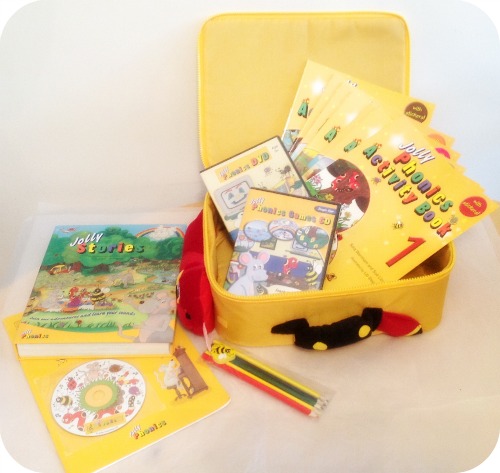For the past six months, The Boy has shown an immense interest in reading and is able to recognise 80% of the alphabet and pronounce the sound (or phoneme) correctly. He astounded us a few weeks ago by leaning over Mr. TBaM's shoulder and reading a simple CVC (consonant-vowel-consonant) word correctly, and then floored us when he continued to read the next ten words correctly by sounding them out (segmenting).
The 'My Jolly Phonics' kit we've been sent to review has come at exactly the right time!

Jolly Phonics is the most widely used programme in schools for teaching children how to read. It splits the 42 phonics into progressive groups to learn, and addresses them in a fun manner.
Inside the beautiful storage bag is:
- a parents' guide;
- Jolly songs;
- activity books;
- Jolly Stories;
- Jolly Phonics games CD;
- Jolly Phonics DVD;
- a packet of coloured pencils (in an outside pocket).
The parents' guide does a brilliant job of explaining the different stages to reading using the method of 'synthetic phonics'. In this case 'synthetic' refers to 'synthesising' the letter sounds together to create words using techniques such as segmenting and blending. It's an incredibly well explained guide and one that helps to understand the process of learning to read a lot better.
Every phonic in the Jolly Phonics programme has a character and action associated with it. Jolly Songs is a brilliant resource for helping children to learn these, and because it's a CD it can be played while doing another activity and through sheer osmosis, the actions and sounds are learnt. The accompanying booklet has suggested games for parents to supplement the songs.
Inside the kit are seven activity books; one for each of the seven groups of phonics. The activity books are really good quality; full colour with a good mix of stories, discussion points, sticker activities, practical games to play, physical activities developing both gross and fine motor skills, and notes for parents. I think the activity books are one of the best resources that Jolly Phonics producs.
Jolly Stories is a hardback story book with seven stories inside; one for each group of phonics. The pages are thick, colourful and have a large focused letter on them which the child can trace with his finger to develop formational skills. The stories focus on the characters and Jolly Phonics actions in context, and are a great way of consolidating the relevant phoneme.
I had some trouble installing the Jolly Phonics Games CD and had to put it on my school laptop as it wouldn't load onto my own machine. Both are running Windows 7 so I'm not sure what went wrong (The CD can be installed on both Windows and Mac machines). During the setup it's possible to select either precursive or print letters, and suggests that in the UK we install the precursive font, which I did anyway because that's what I use in the classroom. There are three levels of play; easy, medium or hard, with plenty of activities and games within each one. I would like to point out that it's worth reading the manual because some of the games (even in the easy level) rely on understanding how to blend phonics together, and this would cause children trouble unless they've got a firm grasp on the basic phonics of that level first.
The Jolly Phonics DVD features episodes from the 1995 television series which, as they are 17 years old, aren't of a brilliant recording quality. However the content is just as relevant. It actually reminded me a little of Fingermouse from my own childhood and the characters, props and images are bright and attractive. The only thing that jarred my professional nerves slightly was the inconsistent pronounciation. The first episode focuse on 'S', 'A', 'T' (the first collection of phonics taught), yet pronounciation ranges from 'sss' to 'suh' and 't' (blunt ended) to 'tuh'. This 'uh' sound, the schwa, is avoided at all costs in phonics teaching nowadays as it gives a false phonics awareness. I think the variation in the way the phonics were said sends mixed messages to young children learning to read.
As a parent I have found this set invaluable, as a teacher it was just as helpful. I specialised in teaching junior aged children who can invariably read by the time they get to my class. I've never been taught how to help a child read, and it's only through common sense, and now my own practise with The Boy that I really appreciate the different processes involved. However, many parents who don't know where to start when supporting their child in learning to read are scared of 'getting it wrong' (rightly so) and this starter kit is a great toolkit for exactly this purpose.
Overall it's a really good resource and I would recommend it.
I was sent this product for the purpose of this review, my opinion as a parent and teacher are honest and unbiased.


